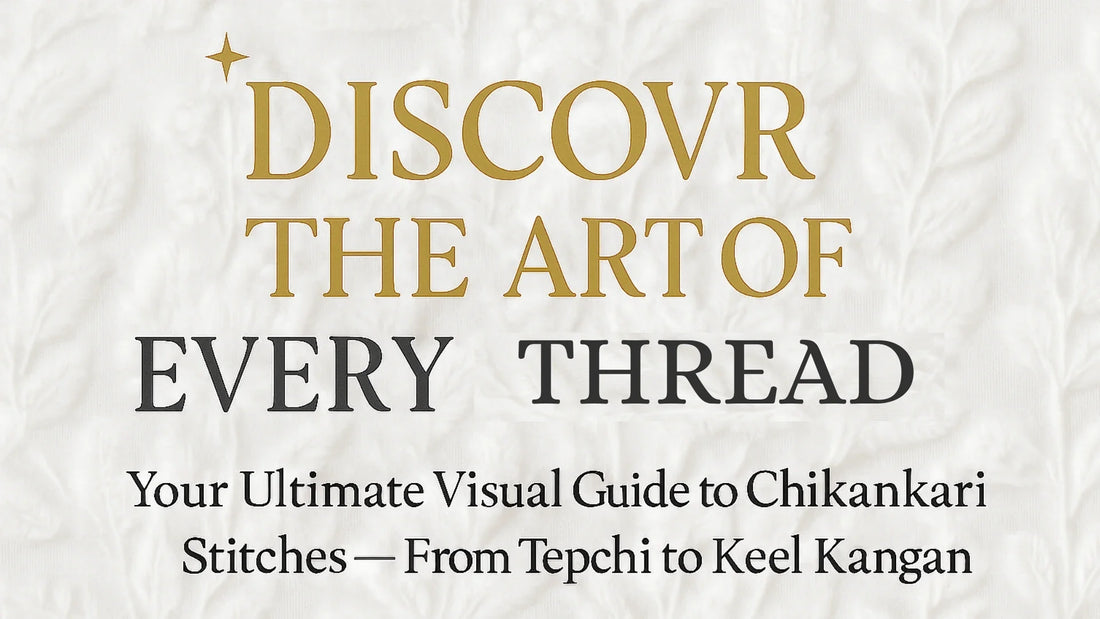
Chikankari Stitches You Should Know: A Visual Guide to Tepchi, Phanda, Keel & More
Share
In the heart of Lucknow’s timeless textile heritage lies a delicate and enchanting embroidery style known as Chikankari. With roots tracing back to the Mughal era, this hand embroidery technique tells stories of tradition, craftsmanship, and quiet luxury—one stitch at a time.
If you've ever admired a chikankari kurta or saree and wondered how those intricate designs come to life, this guide is for you. Let's explore the essential stitches of Chikankari—each with its unique identity and purpose.
1. Tepchi (तेंपची)
The Foundation Stitch
- Type: Running Stitch
- Used For: Outlines, basic filling, borders
- Visual: Simple, straight lines
- Where You’ll See It: On kurtas, dupattas, and sarees with minimal motifs
Tepchi is often the first stitch every Chikankari artisan learns. It forms the skeletal outline of motifs and provides structure. Its simplicity is what makes it so elegant and versatile.
2. Phanda (फंदा)
The Knot That Blooms
- Type: Knotted stitch
- Used For: Floral centers, decorative dots
- Visual: Tiny raised knots
-
Where You’ll See It: Center of flowers, scattered embellishments

Delicate and decorative, Phanda resembles tiny beads. It adds dimension and character to floral patterns and is often used to mimic the texture of buds or pearls.
3. Keel Kangan (कील-कंगन)
Spiked and Circular Beauty
- Type: Combination stitch (straight + looped)
- Used For: Petals and circular floral designs
- Visual: Central knot with radiating lines (like a flower)
- Where You’ll See It: Heavier motifs on formal wear
A more ornate stitch, Keel Kangan is used when artisans want to add richness. It requires precision and is usually done on higher-end pieces meant for festive or bridal wear.
4. Bakhiya (भकिया)
The Shadow Stitch
- Type: Double back stitch (done from the back)
- Variants: Ulti Bakhiya (Shadow), Sidhi Bakhiya (Satin)
- Used For: Filling inside motifs
- Visual: Creates a shadow or translucent effect
- Where You’ll See It: Fills in petals, leaves, and paisleys
Ulti Bakhiya is especially admired for its sheer magic—it appears like a shadow on the fabric from the front, lending an illusion of depth without heaviness.

5. Murri (मुरी)
The Grain-Like Knot
- Type: Rice grain stitch
- Used For: Center of flowers, eyelets
- Visual: Small grain-like raised stitches
- Where You’ll See It: Dense floral motifs
This highly detailed stitch mimics a grain of rice. Murri is labor-intensive and is often used in finer garments. It reflects the artisan’s skill and patience.
6. Jaali (जाली)
The Open Net Work
- Type: Thread pulling and knotting
- Used For: Net-like texture
- Visual: Fine mesh, lace-like feel
- Where You’ll See It: Dupattas, saree borders, back of blouses
One of the most laborious stitches in Chikankari, Jaali is crafted without cutting the fabric. It’s made by skillfully loosening the threads and knotting them to create openwork, similar to lace.
Why These Stitches Matter
Each stitch in Chikankari serves a functional and aesthetic purpose, and no two pieces are exactly alike. The handwork, the slight imperfections, and the story behind each motif make Chikankari not just embroidery—but a legacy worn on skin.
Visual Tip: How to Identify the Stitches
When shopping or browsing through Chikankari:
- Look for raised knots → it's Phanda or Murri
- Observe net-like patterns → likely Jaali
- Notice straight-line outlines → that’s Tepchi
- See petal fillings with shadow effect → it’s Bakhiya
Final Thoughts
Chikankari is more than just an embroidery technique—it’s a language of thread, passed down generations. Whether you wear it for everyday grace or festive finesse, knowing the stitches adds deeper appreciation for the craft and the hands behind it.
Ready to choose your next Chikankari piece?
Now that you know your Tepchi from your Murri, you’ll shop with a sharper eye—and deeper respect—for this beautiful heritage.
